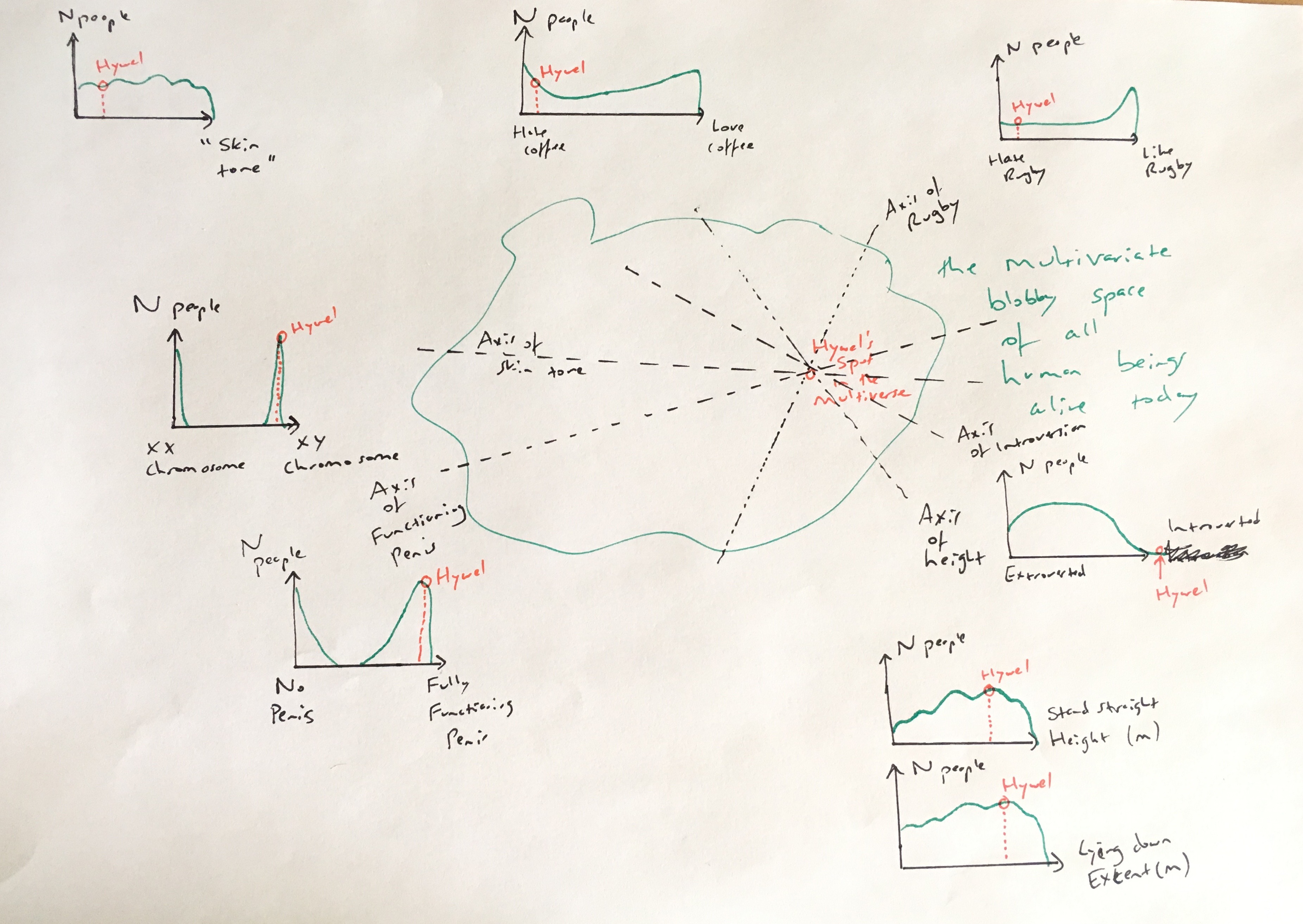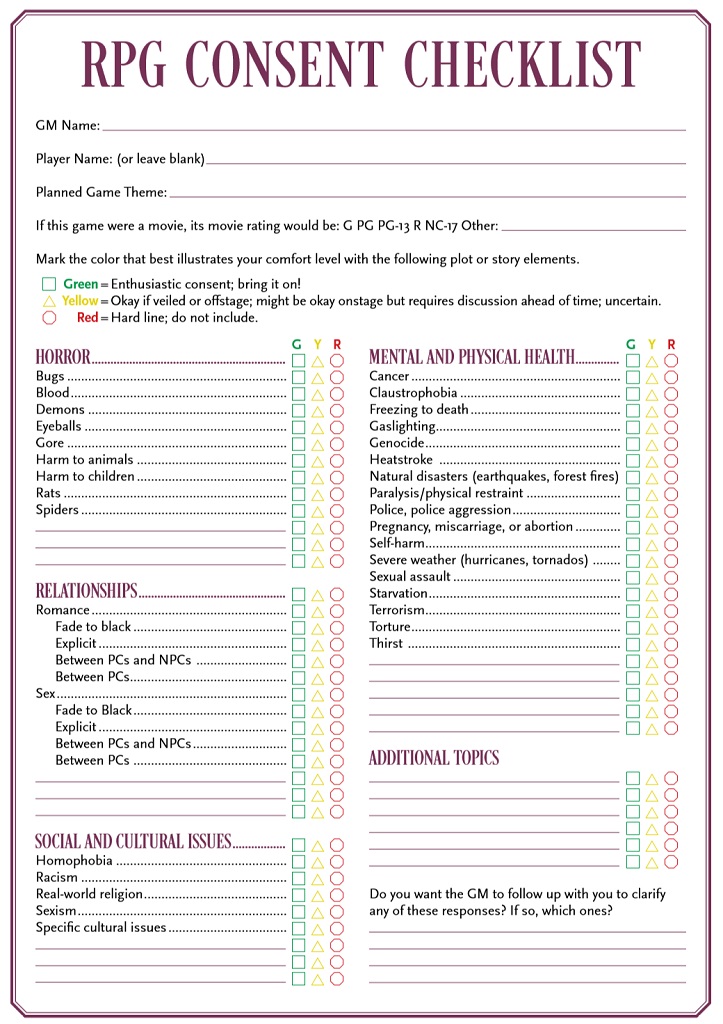Hi All,
Fair warning: this is another politics-and-equality-related ramble. If you’re here for the BDSM, probably wise to skip it. I wrote and didn’t publish this ages ago. But as UK politics has descended further and further into the sewers of othering us-and-them, I thought there were a few ideas worth sharing.
I am no expert in biology, genetics, sociology, psychology, ethics or any of the other areas this touches upon. I’m happy to be corrected, debated, challenged and ridiculed – just kindly keep it civil and remember the golden rule.
The one concept I think is really important is the Infinite Dimensioned Multi-variate space of human beings. What the hell is that when it is at home?
The Infinite Multi-Dimensional Space Of Human Beings
There are an infinite possible number of ways of measuring, describing or classifying people. You could measure their height. You could ask how old they is, what colour their hair is. Some stuff would be trivial, like “People wearing blue socks”. Some will be different ways of measuring the same thing: like date and time of birth, which directly tells you how old someone is when you know the current date and time. But these seemingly redundant measurements are fine, because they are useful for different things. Age is constantly changing but date and time of birth are fixed for a particular person, for example. So sometimes we might find it easier to figure out information by asking about age, other time about date of birth.
We can represent people on a huge number of different axes representing different things about them. An infinite number of axes, in fact, because there’s an infinite number of possible things we could try to measure. I like to envisage this as a huge blobby glowy green cloud in some strange mathematical space somewhere, with individual people glowing like dots in the Cerebro in X-Men.
Axiom: Each of these human beings is completely individual. No two people are alike- even identical twins. You can see that to be true in a trivial sense by including the variable of “occupying the physical volume located at” to describe the person. Identical twins don’t occupy the same physical space, and even conjoined twins don’t occupy ALL the same physical space- if they did they wouldn’t be twins, they’d be one person.
It is also true in the non-trivial sense that not everything about identical twins and conjoined twins is the same. Very similar – even to the extent of sharing the same genome or part of the same physical body- but not actually the same. One can die while the other lives, and “alive or dead” is a pretty important variable in describing the status of any a human being.
All measurements are messy, so we have to combine for usefulness
Some things are relatively easy to define and measure, like height. Even though it changes for an individual throughout their life, at any given time a human being takes up a certain amount of physical space in the y-dimension.
Even here I’m thinking of possible exceptions even to this rule- there might be rare cases where for some reason it might be hard to measure, such as in the case of an extreme stoop, so you might have to be careful in your definition!
But that’s OK. We’re in the infinite multi-dimensional space of “possible ways of describing a human being”. It’s always OK to chuck another dimension in. It might tell us something new or it might not. Doesn’t matter, just chuck it in. Star sign, for example. Probably doesn’t mean much. Definitely doesn’t meaningfully split people into 12 groups in a useful way. But still might influence people – not least because people who believe in astrology might tend to act more in the way they think they are “supposed” to by their star sign. It’s all fine, chuck in the variable. We can see if it is actually useful when we start to ask questions.
Height
Each measurement system you use is just another variable, another one of infinite directions in this space. Measured distance from flats of feet to top of head while standing, is one variable. Measured distance from tips of toes to furthest point from that whilst lying down with arms lowered is a second.
Whatever definition we choose, whichever variable, there is a distribution of the population of human beings along these axes. Each individual is a single glowing point in this space, but you can see the shape of the landscape around them – how are other human beings distributed through this space?
Some of variables will be so highly correlated as to be almost identical.
Most sensible ways you could think of to measure height, for most people most of the time, will put that person at about the same point in the distribution of human beings.
The height you measure for a whole bunch of people lying down and measuring from the tips of their toes to the furthest distance from that point is probably almost 100% correlated with what you measure doing flats of feet to top of head whilst standing for them.
The actual numbers for these two different ways of height might be different- gravity squashes us progressively through the day, so measuring “stand up straight” height in the evening might well give a smaller absolute number in metres and centimetres than that same person’s “lying down extent” measurement. And those differences might vary from person to person: an older, taller man might get squashed more during the day than a younger, shorter girl, say.
But someone who is “tall” by one measure is very likely “tall” by other measures too.
There will be exceptions, like people who are unable to stand upright. One measurement might give a misleading figure for some people, or might not even have a well-defined value for some individuals.
That’s fine- that’s why we look at a LOT of variables. We can look at as many we like, and see if any happen to be of use in understanding anything about humans.
This cluster of variables (ways of measuring vertical extent of human beings) is so tightly correlated, so clustered and so nicely in correspondence to the every-day experience of most of us that we’ve got a non-technical term for it which does fine for discussion most of the time. We call it “height”.
We only need delve back into the technical details of its definitions if we encounter an edge case. Like, say, Stephen Hawking. How tall was he, towards the end of his life, given that he couldn’t actually “stand up straight” for a regular height measurement?
Let’s not forget that those technicalities are there as we move on to other, messier, less-easy-to-define things. This may seem like nit-picking to you but for people with certain medical conditions it might be a frequent annoyance, dealing with inappropriate or contradictory measurement schemes for height.
I don’t know whether that’s actually the case for any individual human beings out there, but I can imagine that it could be in principle. And as we move on to other variables we’ll see that forgetting these measurement distinctions can lead to very serious consequences for individual human beings, when the generalisations don’t fit the specific circumstances of the person. (“What do you mean, can’t enter your standard height on the medical form because you can’t stand up to measure it, Professor Hawking?”)
Messier Variables
Other things have “everyday” terms but turn out to be more complex – like sex.
There are a significant number of human beings with external genitals which include both “male” and “female” aspects, internal genital differentials likewise. You can’t use chromosome makeup to define it either (there are people with X0 – only one X chromosome; XXY, Androgen insensitivity syndrome, and many more characteristics which are now broadly described as intersex, https://en.wikipedia.org/wiki/Intersex).
But for the sake of argument let’s accept that one can at least define a whole bunch of variables like genitalia and chromosome makeup, on which human beings fall along a multi-dimensional distribution, and which have strongly correlated clusters.
We should be VERY careful about making generalisations which exclude human beings in rare parts of the distributions of these variables- while rare, there are many many millions of human beings with these characteristics which we think of as “intersex”, or intermediate between “male” and “female”.
Remember that some people might not even appear on some axes in the space at all- like in the variable “XX or XY chromosome”, where someone with XXY or X0 doesn’t appear at all because it is not relevant to their situation.
However mindful we are not to ignore those millions of human beings, it remains the case that in making any headway at all about thinking about the distribution of traits and characteristics of human beings we inevitably end up speaking of “men” and “women” or “male” and “female” human beings, in every culture and every time.
A lot of problems come about for people who happen to lie at intermediate points on the variables when we forget that these are all distributions. There is no such thing as a “man” or a “woman”, even less so a “typical man” or “typical woman”!
There are only individual human beings with a spate of characteristics that happen to lie pretty close to the centre of a cluster in multi-variable space that for reasons of practicality, brevity and laziness, we often label as “male” or “man” or “female” or “woman”.
Sex and Gender
If you’re up on your terminology, you might have been bristling in that last section that I’ve mentioned “sex”, “male”, “female”, “man” and “woman” but not gender, trans or queer.
The use of these words has been adopted exactly because of what I was just talking about- the realisation that there are many more variables that should be examined, and a lot of them are at least as important to the human beings concerned as their physical body characteristics.
Gender is used to refer to socially constructed roles, behaviours and attributes, as distinct from the body characteristic ones.
This distinction is very useful in reminding us that there are many, many variables we could look at, and that correlations between them are very rarely perfect.
But it isn’t enough, and we should step back every so often to make sure we’re not doing the “what is your standard height, Professor Hawking” thing.
Some factors will correlate quite closely for large fractions of the population between sex and gender, some will correlate less strongly, some not at all, and for all variables there will very likely be some fraction of individual humans who buck the trend and lie in unusual parts of multi-dimensional space- and we should be careful to remember that, too.
Terms we use for groups of people have no inherent meaning
This is a vital realisation which comes from this picture. There is NO precise and reliable definition for “female” or “man”. Every human being occupies a unique place in the multi-variable space.
They might cluster quite closely together with other humans in bunches in some variables- like having XY chromosomes and a functioning penis. That might even go along with other variables, like liking Rugby football, a lot of the time in some places for some subset of human beings.
But that does NOT mean that “MEN LIKE RUGBY”. “Men” don’t do anything or like anything. “Man” is not a complete or precise or reliable definition of any individual human being, and it most certainly isn’t enough to specify where they sit on all these infinite number of axes!
The terms “Men” and “Women” are useful because in some projections of this multivariable space, looking at a few variables at a time, we observe that very many human beings fall into one of two broad clusters.
So in line with common terminology, like “height” as a short-cut for the cluster of vertical extent measurement techniques, we’re just agreeing to use them as a short-hand which works a lot of the time.
We really must not mistake the label for the person!
This is super, super important.
No two “men” are alike, any more than no two identical twins are actually alike. Two people will be close to each other in some variables, and at opposite ends of the spectrum in other variables. I am quite like a stereotypical man in having a functioning penis.
I am unlike the stereotypical man at least in my local culture by finding team sports in general and Rugby football in particular entirely tedious.
And in some other variables, like liking vs. hating the taste of coffee, it might be that my position on the functioning penis variable may have no bearing at all. (I have no idea whether people with penises are more or less likely to enjoy coffee that those without).
As an individual human being, I’ll be in my own place in this huge multi-dimensional space. Close to one end of some distributions (how introverted I am), entirely boringly typical in a lot of other distributions (my height is distinctly average).
Here’s a diagram to summarise all of that:

The big green blobby thing is the multivariate space of all human beings alive today.
The red dot is Hywel’s spot in the multiverse. That’s me.
If you want to know where I sit along one of the infinite number of variables, you have to “project out” along that axis. We confine our view from infinite dimensions, down to just one. We look along that axis, and for each human being alive today, we add a little “blip”.
That lets us plot a histogram, which are the black graphs. Each histogram shows the number of people with a certain value of the variable we’ve projected out along. The green curve shows the distribution of all human beings alive on that single axis.
Let’s look at the two bottom right graphs first. These are the “standing straight height” and “lying down extent” distributions. I’ve drawn in some wibbly wobbly line to represent what we’d find if we actually made this plot for all human beings alive.
If you look a certain way along the horizontal axis, you’d find a specific height in metres, say 1.75 m or about 5 foot 9 inches. The green curve tells you how many human beings alive today have that height.*
*(Two minor technical points- strictly speaking you have to specify the number of people in a RANGE of heights, say from 1.75 to 1.76 m, when making this sort of plot, and you can either choose to have the absolute number of human beings as the green curve, or you could divide by the total number of people and have the fraction of people with that height. But the basic idea is the higher the green curve, the larger the fraction of people with that height).
I’ve drawn myself, my own little +1 human blip, to the 1.75 m point. This puts me pretty much bang at the average height for adult men where I live, and is why I drew the wibbles in the green curve to have a peak around there. It’s only a sketch, we’d have to look at the real distribution to get proper information.
I also drew a second bump lower down, to represent the observation that women are on average shorter than men. There is a tail down to almost zero height, but I should have drawn it more carefully because there’s a minimum viable height for a living (and already born) human being, so there should really be more of a cut-off at the lower end. There’s a tail off to bigger heights to, and there is a maximum height- at the time of writing thought to be Sultan, who is 2.465 m tall (8ft 1in).
Underneath the “stand straight height” I drew the “lying down extent” measurement, which has almost an identical shape, with me in the corresponding place. These are almost but not quite the same distributions, and the correlation between them is extremely high- if someone is tall by one measure, they are very likely indeed to be tall by other measures, too.
Then I’ve drawn a few other projections for variables we’ve talked about. It’s not clear how we’d quantify something like “Having a fully-functioning penis” but that’s OK- think up some reasonable proxy measurement, or a group of them, and we’ll get the basic idea.
I’ve drawn this peculiar variable with a couple of peaks, one to represent “women” (no functioning penis), one to represent “men” (human beings with a functioning penis) and with some vague tails to represent erectile disfunction, accidents, prostate patients, intersex people and so on. There I am, someplace around the “fully functioning penis” peak of the distribution. Yay me.
Above it is the “XX – XY chromosome” variable, whatever measurement technique we use to put that into our multidimensional space. Two peaks, one for people with XX, one for people with XY, and importantly millions of people who don’t appear on this projection at all because they don’t possess either of those binary options and are therefore cannot be shown in this particular projection. This doesn’t make them non-people, and erasing them does them a massive disservice.
If we looked at the correlation between “functioning penis” and “XX-XY” we’d again see a pretty strong correlation, as we did with the two different height measurement techniques.
(As an aside here if you’re not familiar with the idea of correlation and the difference between correlation and cause, now might be a good time for a quick wikipedia break:
https://en.wikipedia.org/wiki/Correlation_and_dependence
https://en.wikipedia.org/wiki/Correlation_does_not_imply_causation
)
Perhaps surprisingly, we’d find the correlation was way weaker than between the two methods of measuring height. It’s actually quite hard to think up ways in which sensible ways of measuring height would come up with radically different answers for the same human being. But there are plenty of ways someone with an XY chromosome might end up without a functioning penis. Accident or infirmity or elective surgery or temporary impotence. (You might improve the correlation by choosing a slightly different variable, like “have at one time had a functioning penis”).
In the cloud around the diagram I’ve sketched a few other variables and plotted myself on them, like love vs. hate coffee and love vs. hate Rugby. I’ve totally made up the statistics- I have no idea either how one would measure these or what the distribution of the world population would be like if you did. Deceptively simple variables like these hide plenty of “What is your height, Professor Hawking”? traps too- some blessed fraction of the world’s population wouldn’t appear on the love vs. hate Rugby plot at all, by virtue of never having been exposed to the wretched game in the first place.
And One More Thing
Notice the innocuous little graph at the top right which I’ve called “skin tone”. Let’s say that we come up with some measurement for human skin tone. Something to do with amount of melatonin in the skin, or reflectivity tested with a colour reflectance meter, or position on a printed colour chart. As before what we really have to do is to use all of those variables, and many more besides, because none of the measurements are quite the same and there are always reasons why a few individuals might not appear or be in a surprising place even if the measurements are highly correlated.
I’ve drawn a wibbly green line with me at a random position on it.
Race isn’t a real thing. It’s impossible to define in any meaningful way that stands up to the slightest scrutiny. https://www.amazon.co.uk/Brief-History-Everyone-Ever-Lived/dp/0297609378.
Differences and Similarities between people
Right, now we have our infinite dimensioned space of all human beings. How can we assess differences and similarities between people? And can that tell us anything about equality?
Well, it’s tricky. We can see that people could be clustered together in lots and lots of ways. People with fully-functioning penises are very likely to have XY chromosomes… and people without functioning penises are very likely to have XX chromosomes. But people without functioning penises who once did have functioning penises are very likely to have XY chromosomes. It gets complicated really quickly when you start zooming in, because individual humans can pop in unexpected pockets in the distributions which don’t show up until you start to look at things in detail.
We do notice definite clustering effects. The vast majority of human beings fall into either the XY or XX chromosome peaks (even though there are millions of people who do not). And a LOT of other things genuinely do tend to be correlated with that.
This is where the “sex is a real thing” folks come in, and in one sense they do have a point. Observably, looking at the whole population, there are clear trends which cluster strongly together.
For example, the average height of people found in the XY peak in that dimension is greater than the average height of people found in the XX peak. “Men tend to be taller than women”, we generalise. Oh, you probably huff in annoyance at this point. “We bloody knew that! 3000+ words to get that far!”
But here’s the thing. “Men tend to be taller than women” hides an awful lot of edge case stuff going on. Like the exact definition of height (a bit trivial, I’ll admit) or the exact definition of a man (not at all trivial, as the existence of many millions of non XX/XY human beings and people with only partially functioning penises and all the rest of it attest).
Furthermore, it leads to dangerous generalisations because it ignores other factors which may be very relevant- like what country that person is from. The average height of women from the Netherlands is around 1.70 m, whereas the average height of men from Nepal is 1.63m. So the average Dutch woman is actually taller than the average Nepali man! https://en.wikipedia.org/wiki/List_of_average_human_height_worldwide.
This swiftly leads into even more dangerous thinking if we get lazy and say “men are taller than women”. “Men” aren’t anything, but even taking “the cluster of humans around XY” as a proxy, it tells you nothing at all about the height of any specific, individual human being in the world. I am a very prosaic 1.75 m or so tall; my wife is a fine and upstanding 1.89 m or thereabouts.
So an individual tall woman can be taller than an individual short man or she can be taller than the average for XY humans or whatever. Her possession of XX chromosomes and lack of penis might lead us to venture a statistical guess that she is LIKELY, statistically, to be shorter than the average XY. But in the case of any individual human being, that might well be totally wrong.
We may know that intellectually, but we drift into magical thinking and stereotyping so easily that this rapidly drifts into “men SHOULD be taller than women”, which is one of the reasons that Ariel and I get stares when we go out on dates together. And this sort of “ought to be” authoritarian thinking seeps into culture and makes tall women think that they “ought” to go out with a man who is taller than them, so they don’t feel like “the man”. (I’ve put it that way around rather than the converse because Ariel has expressed feeling that pressure, whereas I haven’t really experienced the “you’re too short to be with that woman” pressure that I’m conscious of. I just sometimes get taken to be her elderly relative rather than her husband, despite us only differing in age by about 15%).
And there are a LOT of variables. No human being will be “typical” of any cluster they happen to fall into in all of the variables. Very likely, because there are so many possible variables, there will be at least some where they are notably different from other humans who fall into a cluster with them in other variables. (Like me and Rugby).
In fact there is no unique single way to decide how alike two people are (technically, you’d have to define a “metric” – a co-ordinate system which tells you how to add up a difference in variables which are entirely dissimilar. Like XX-vs-XY (which is basically binary and excludes a bunch of people) – how do you “add” a difference in that to a difference in height or in loving coffee?
There’s no unique way to define how different people are, as a corollary. How far apart, and on which variables, do you need to be as an intersex person before you fall outside the “male” cluster? There is no universal answer, only an arbitrary choice of distance metric trying to squeeze an individual human being into an artificially defined category which might simply not be any sort of fit at all.
Sex is real? There are some broad features showing clusters of individual human beings in some axes, yes. But that tells you NOTHING about any particular individual person you might meet and thinking that it will is lazy thinking – so much so as to be extremely dangerous.
Equality
As an illustrative example I’d like to talk about equality in the workplace, starting with sexual equality.
Women currently make up just 5% of the CEOs of Fortune 500 companies. http://fortune.com/2018/05/21/women-fortune-500-2018/
This is surely an egregious example of sexual inequality and discrimination.
It very likely is. But my question is – how do we know? If we are to take remedial action- which we probably should- should we not have some sort of metric by which we judge our success? It would be nice to be able to say we’ve made progress.
One’s first instinct is to say “well, women are 50% of the population, so it should be 50%”.
Indeed, as a starting place I’ll probably agree with you. But probably not for the reasons you think.
The reason I’ll agree with you is that until very recently, by authoritarian dictat the fraction of women in these jobs was artificially forced to be 0. The operational definition of “women” here is anyone who the people in charge say are women, correlated very strongly with most of “conventional” definitions like XX/have a vagina/present socially as female within that culture.
In an ideal world, the variable “is the CEO of a Fortune 500 company” would be very strongly related to the variable “competence and skill at running a Fortune 500 company”.
We have no actual idea what fraction of human beings have the competence and skill to run a Fortune 500 company. We have no idea how that correlates with XY/XX, penis/vagina, or any other variables which we’ll shortcut to “man/woman” at this point.
All we know is that regardless of competence and skill, until very recently the chance of a woman being CEO of a Fortune 500 company was artificially forced to be zero.
What is the “ideal” number? Well, it depends on the far tails of a distribution of skill at running a large company, I guess. Not very many human beings have that skill, and we have no idea whether of those people at the far upper end of that distribution all the human beings are men, or all women, or a mix of both, or what the ratio is. The force of history means we’ve never allowed that experiment to even be tried.
It might be that the traits which make one a good CEO correlate so strongly with being an XY that all the people at that end of the distribution are men, in the way that all the really, really, really tallest of the tall people in the world are men.
Or it might be that it correlates so strongly with being a woman that this is an injustice and inefficiency of truly mind-blowing proportions and 99% of the CEOs ought to be women. Or maybe people who have some combination of both might be masterful CEOs if only given the chance. It could be that a small group of people who are intersex should be running the show. Or people who display some of the suite of characteristics we label as “Asperger’s”.
It might well be a lot more complicated than that, because it could depend on situational factors… a fairly compelling example being the possibility that women might perform better if there are a certain fraction of other women around in the company, and worse if a different fraction of women. Margaret Thatcher and the male cabinet ministers, or a more collegiate style working which is reputed to come about in some female-led workplaces. Some people who fit broadly in the “women” cluster might do very well if surrounded by other people in the “women” cluster; others might do really badly but might shine if totally surrounded by yes-“men”. We just don’t know.
So the answer is very complex. Getting a 50% ratio in a few decades time doesn’t mean it is right or we are done; we still may not know what the “ideal meritocracy” solution number is. So it is very difficult indeed to know whether or not we’re granting equality.
It’s an absolute bastard of a problem!
Worse, it allows Snorting John the male chauvinist arse to make unwarranted claims about “It’s a man’s job love get back in the kitchen” and all the rest of the endless fuckwittery poured down on women’s heads day by day, minute by minute.
But we do no-one any favours by pretending we know the answer is that everything is right with Fortune 500 company CEOs if we have equal numbers of men and women in the jobs. Not only do we have limited ideas how to tackle the problem, we don’t even really know how to measure our progress. For a real meritocracy we might be aiming for 90%… or 9%. Or 0% because the people who would really be doing the best jobs fall outside the typical “man” and “woman” clusters. We simply don’t know. It’s a real bugger.
So do we just throw up our hands and give up?
Equality of Opportunity and Equality of Reward for Measurable Things
No. We start off by saying that we don’t know what the “optimal” faction of people with label X doing job Y might be. So we’ve got no reason to discourage anyone from having a go. We should provide them equal opportunity, and do our best to police the process so that if they’re actually really good at it, they can succeed. We should stop looking at the labels and care much more about the thing they’re actually doing.
Representation helps a lot. Showing that there are people who share labels with you who can do a thing certainly seems to empower people to go for it and succeed. (“A woman can be prime minister”. “A gay dude can be an action hero”).
We must tackle broader structural inequalities, especially those that have glaringly-obvious historical basis.
Like saying “no female CEOs”. Fuck that, obviously.
Police things like promotion and salary tracked by observable, measurable performance indicators. In my own field, particle physics, in the UK, it was clear that amongst people with the same exam results or measured achievements, the fraction of people who went further towards a career in the field was radically different between men and women at every step along the way. To the extent that there was just one female particle physics professor in the country at the time. Faced with that sort of evidence it seems pretty clear that your field is getting something wrong and needs to change. (It did, although I’m sure there’s still a hell of a way to go).
Like the fact that the richest families in Florence today are the same rich families from 600 years ago (https://anarchimedia.com/2019/01/15/rich-families-in-florence-today-are-the-same-rich-families-from-600-years-ago/). The chances of that being due to those people having some magical family clustering on the “great at running a business” axis are slim compared with the chance of it being a historical tendency of capitalism and a failure to redistribute and give someone else’s family a go. Britain is not a richer country than Mozambique because people born in Britain are clustered in some mythical white-supremacist-wet-dream-master-race cluster of supernatural wealth-generators. Chances are very high indeed that it’s physical, geographical and most of all historical factors, not anything to do with the inherent properties of the individuals born there.
Rampant racism is fucking nonsense, as is classism, which clearly runs deep through British society. There’s just NO WAY that the factors which make a good UK cabinet minister are so tightly correlated with attendance at one of a very small number of private schools because of merit, rather than social exclusion.
Take-away Message: People Are Not Labels
This has been a ramble, I was putting some of my own thoughts down and it doesn’t have quite the through-line I usually try to provide in my posts. I got distracted.
Important points:
- We are all in a minority of one.
- We sit at different points in all of the axes of infinite multi-dimensional space of human beings.
- Labels are gross generalisations which I would contend are much more often harmful than useful. They are not real. Being a man is not a real thing. Being a woman is not a real thing. There are just human beings in infinite multi-dimensional person space, sharing more or less of certain characteristics with other human beings.
- Physical reality always presents edge cases. How high was Stephen Hawking? Is an intersex XXY person a man or a woman? (The answer is “no, and nor is anyone else”).
- Mistaking the label for the people is pernicious evil and we should stop doing it. We should all start saying “People” instead. “The Welsh” don’t think or do or possess characteristics, it’s not even a well-defined term. People born in Wales? People who live here? People who moved here when they were a kid but moved to England in 1999?
- You can speak about people in aggregate only by being clear about what axes in multi-dimensional space you are considering. Then you can start to make meaningful statements. Like that “people who were educated in schools in Wales” are much more likely to speak Welsh than people educated in schools elsewhere”. Which might sound stupid but has some actual meaning, unlike something like “The Welsh have a sweet tooth” or “Whites are superior” or “Women shouldn’t be CEOs” or “The Welsh are sheep shaggers” or “The Chinaman is mean and not to be trusted”. Which are pernicious lies, not even wrong but hugely corrosive and damaging and an awful way to think.
END RANT.



























































